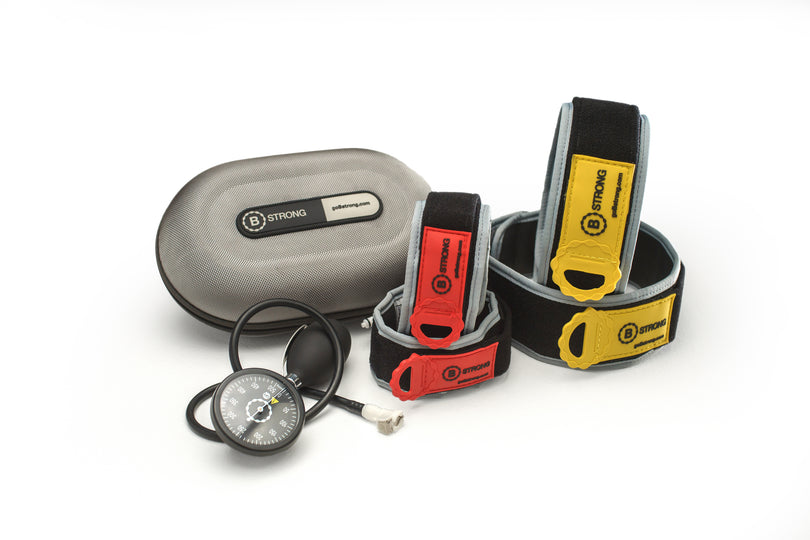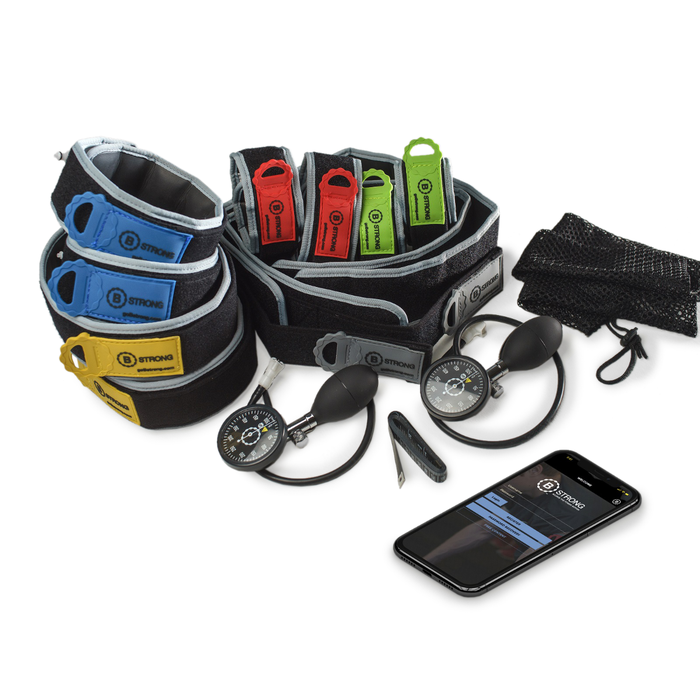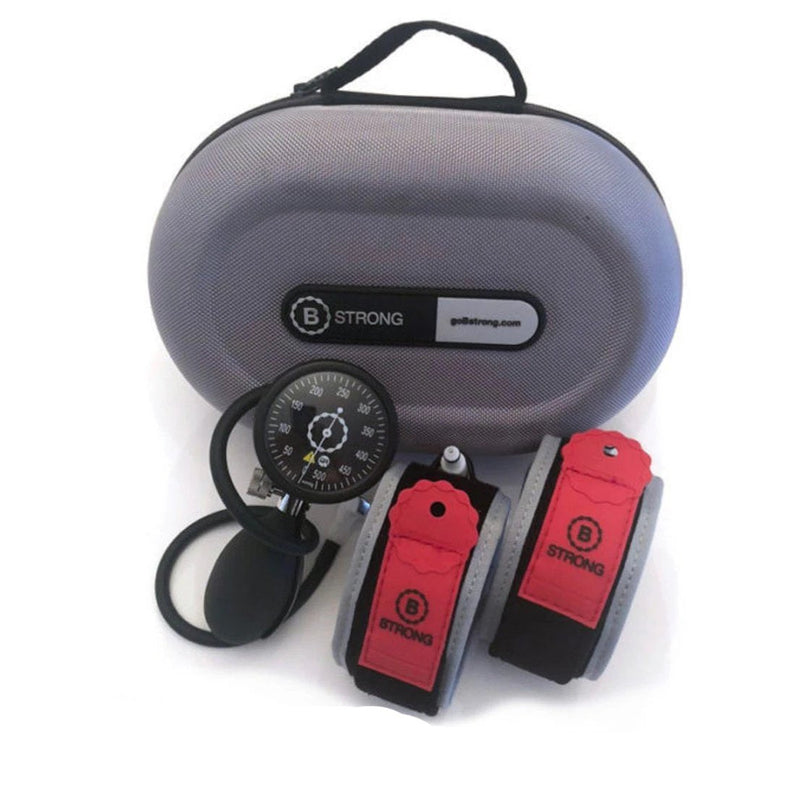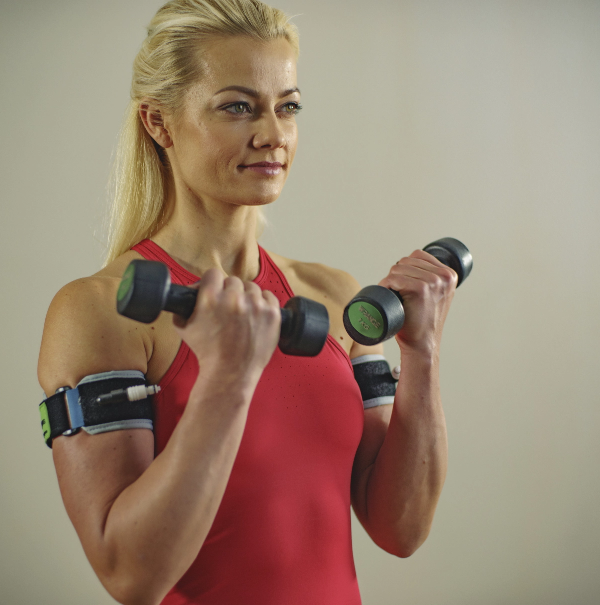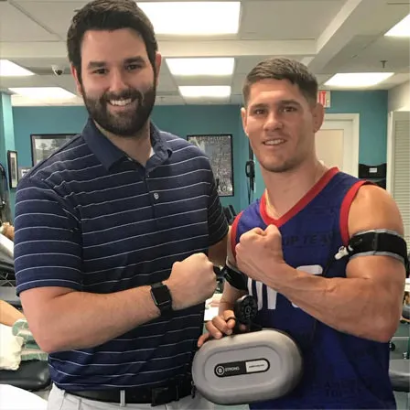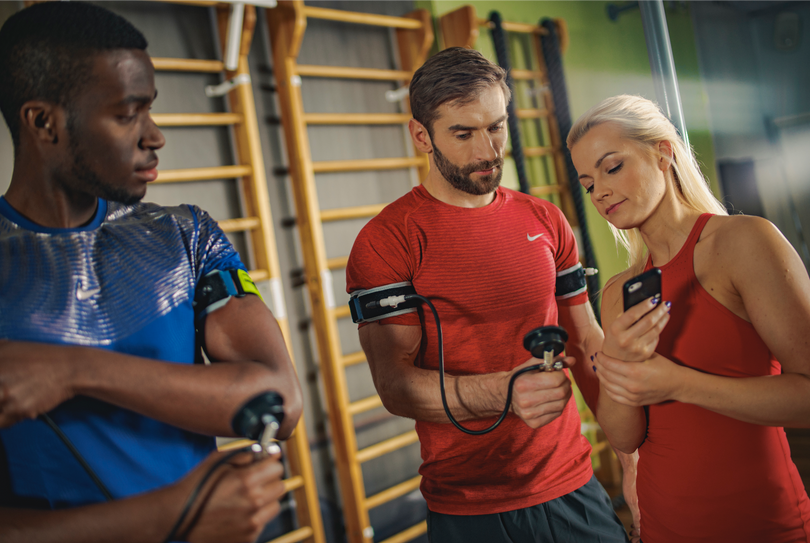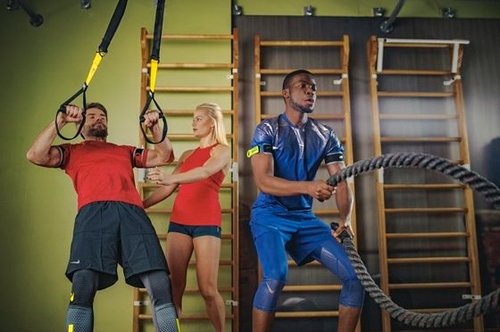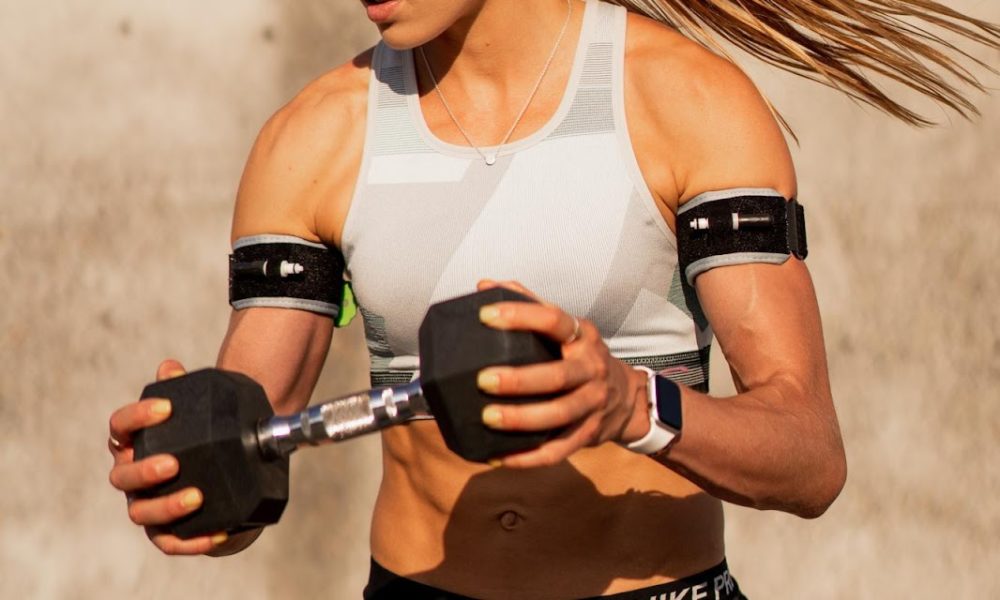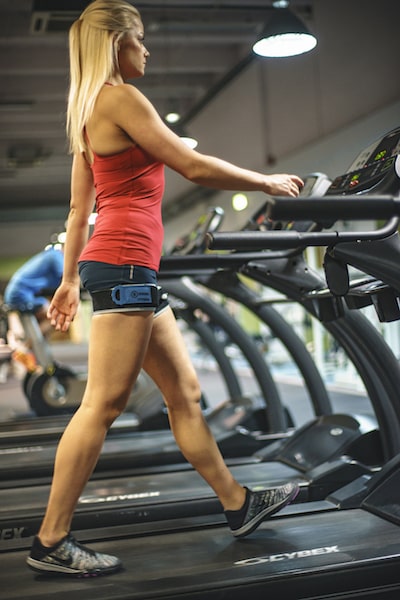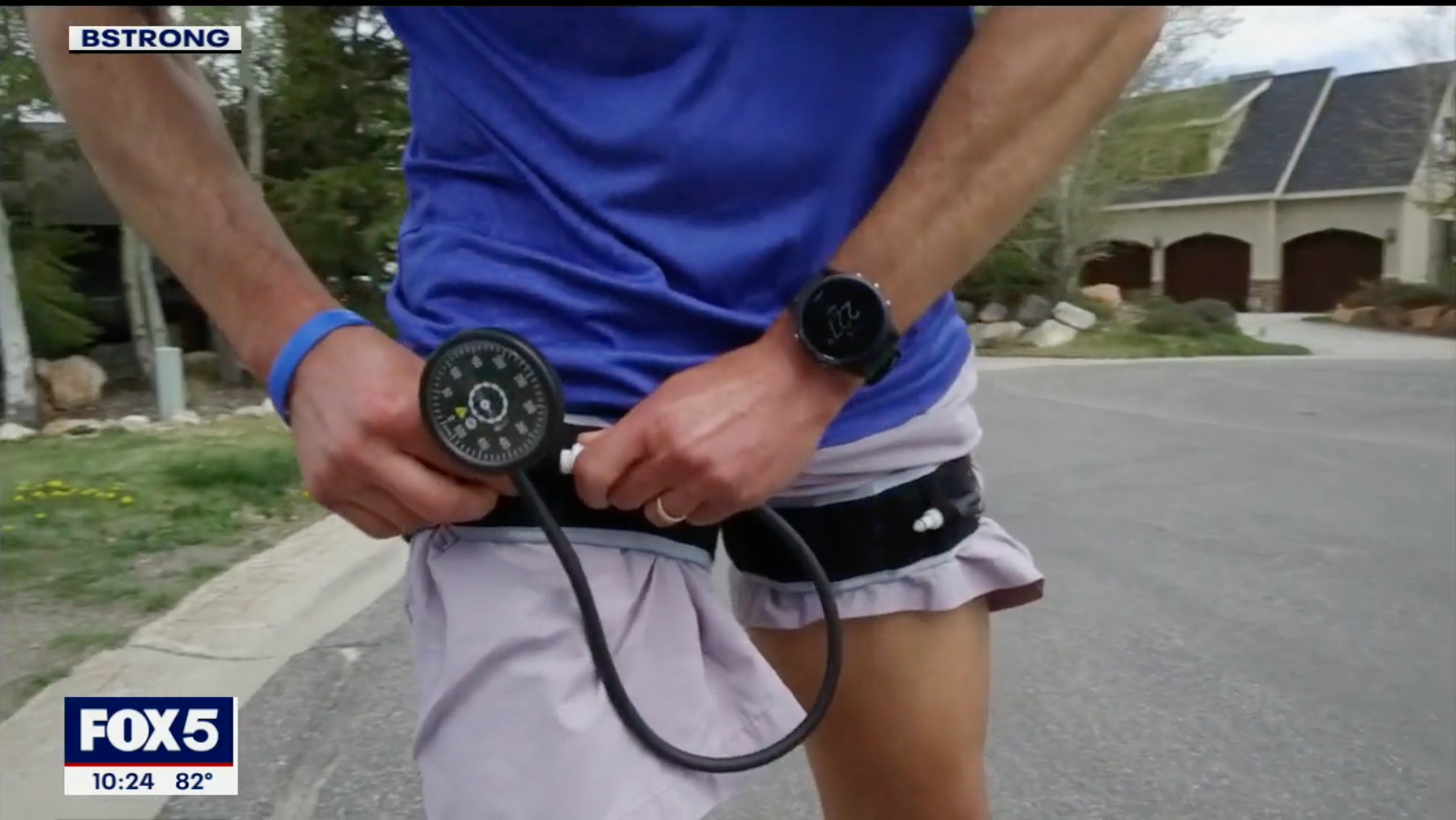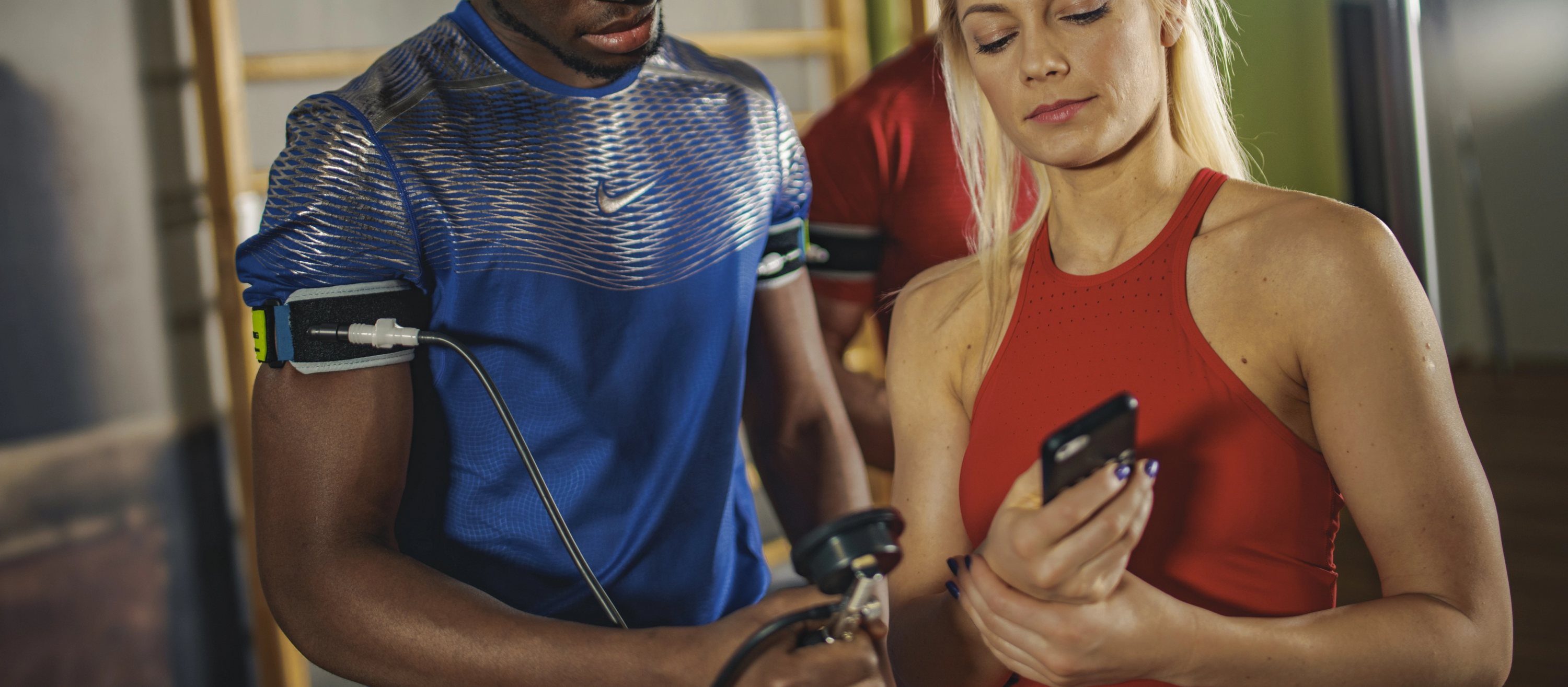WHAT IS BLOOD FLOW RESTRICTION TRAINING (BFR TRAINING)?
All athletes (and pretty much everyone else) are always looking for the next best thing, the thing that allows them to get to that next level and take their performances to new heights. One of the more prolific topics of the last year in the world of rehabilitation and sports training and performance is the use of blood flow restriction training. BFR training utilizes a strap, band or cuff placed on the upper portion of one or multiple limbs intending to impede or restrict the working muscles from receiving sufficient blood and oxygen, combined with calisthenics or light resistance exercise, to produce a variety of positive physiological effects.
These include increases in muscular strength, improved tendon strength, increase in bone density, reduction in fat stores and angiogenesis (the building new and better blood vessels). These effects can be utilized to rehabilitate an injury, improve athletic performance, improve overall health and fitness, as well as, help the elderly maintain their ability to carry out their daily chores and activities. Although this technique may be unfamiliar to many, this is a strength system where studies first appeared in the English literature around the year 2000. However, BFR training was first developed in Japan in the 1970’s and 80’s.
Due to reports of impressive, quick results coming from Japan, considerable amounts of research have been conducted to understanding of the mechanism(s) of how BFR training could be beneficial, as well as, how to safely implement this technique into your current training.
WHY SHOULD I USE BFR TRAINING?
In short, BFR training makes efficient use of your training time and allows one to make significant gains in fitness in, while minimizing the risk of injury. When it comes to strength training, the American College of Sports Medicine recommends working out with resistances that are 70% to 80% of one’s max. When 8- week strength programs of high intensity and low-intensity strengthening have been compared, studies have consistently shown that low load training fails to produce muscle hypertrophy as compared to those who complete heavy load training. The problem with standard heavy load training is that it always produces some damage and can risk injury, if, for example, one loses control of the weight. In addition, people recovering from injury or operations and those with chronic injuries or illnesses cannot tolerate the heavy loads. In a situation like this, implementing the use of BFR training would be an effective choice to allow for continued improvements in strength and fitness. Takarada et. al. published a paper in the Journal of Applied Physiology in 2000 (see Figure 1 below), demonstrating that the combination of light loads (30% of 1RM) plus BFR (panel B in Fig 1) could produce the same increase in strength and muscle size as standard high load training (panel A in Fig 1). Other studies have been able to demonstrate gains could be achieved with various other types of exercises/sports including, running, cycling, walking, swimming, speed skating, sumo, baseball, golf and soccer, as well as, in all age groups. There is a way for everyone to benefit from a B Strong training program.

So how does the use of BFR training help these various sports and activities? With the combination of light, otherwise easy exercises and BFR, muscle fibers fatigue much quicker than normal as the muscle environment gets hypoxic and acidic. The combination of both the physical and chemical stressors with BFR training has been described as the “primary hypertrophic factors” needed to initiate the other processes required for muscle growth.
Eventually, the muscle fiber cannot regenerate the intracellular phosphates (source of energy for all cells) necessary to sustain muscular contractions. Both hypoxia and acidosis stimulate the muscle fiber to make more proteins (up regulate protein synthesis) and thus, the muscle grows and improves its ability to produce force (strength). In addition, anabolic hormone receptors are sent to the muscle cell surface to be able to bind to any anabolic hormones that come their way. The brain recognizes this fatigue signal and reacts by releasing neuro hormones including growth hormone (GH), into the circulation. Growth hormone, in turn, stimulates more anabolic hormone release, which, in turn, amplifies the local increases in protein synthesis.
This anabolic hormonal milieu that is created, circulates throughout the body and facilitates improvements in all tissues (blood vessels, nerves, muscle, tendon, bone) that were involved in the exercise. In addition to those benefits, BFR training breaks down and uses fat stores, such that the individual becomes leaner.

WHAT ARE THE PHYSIOLOGICAL BENEFITS OF BFRT?
IN SHORT, BFR TRAINING IS ANTI-AGING MEDICINE
Table 1
1. Increase in muscle strength
2. Increase in tendon strength
3. Increase in bone density
4. Angiogenesis, making new and improved blood vessels
5. Improvement in efficacy of nerve function
6. Increase in leanness, reduction in body fat
7. Improvement in skin, hair and nails
8. Improve cardiac function and aerobic power
9. Improved brain function and cognitive abilities
10. Increase in lipido, increase in testosterone levels
11. Improve sleep
12. Improve insulin resistance
13. Reduction in resting blood pressure
14. Heal injuries faster
15. Improve fatigue resistance
Two of the most prominent benefits from the use of BFR training is the increase in strength and the increase in leanness or reduction of body fat stores. In addition, all 15 of the items listed in Table 1 have been documented to greater or lesser degrees, with evidence ranging from anecdotal case reports to well done peer reviewed studies. This is why we call it “anti-aging” medicine. Many of these same effects can be obtained by regular exercise, but they are easier to obtain with BFR training, particularly for people who can’t tolerate heavy loads or intense aerobic exercise. BFR training can improve performance in all sports and physical activities
ARE ALL BFR TRAINING BANDS AND CUFFS ALIKE? DEFINITELY NOT!
There are order of magnitude differences in prices for BFR Training systems. Why is that? Basically, the systems range from elastic or rigid belts that cost a few dollars, to systems that are electronically controlled and sessions monitored, costing thousands of dollars. There are two main features that account for the huge range in price. First, whether or not there is an inflatable component and, second, whether or not the band/cuff material is elastic or rigid. Mostly, this has to do with device safety. There are other differences between systems. Table 2 below provides a comparison of a few of the more common systems.
Table 2.
| Price | Safety | Efficacy | Comfort | Power Needed? | Inflatable? |
Elastic? |
|
| Delfi | $7,000 for one cuff | Very uncomfortable | Yes | Yes | No | ||
| Kaatsu | $1,000 to $5,000 for 4 bands | Somewhat uncomfortable | Yes | Yes | Yes | ||
| B Strong | $430 for 4 cuffs | The most comfortable | No | Yes | Yes | ||
| Smart Cuffs | $400 for 4 cuffs | uncomfortable | Yes | Yes | No | ||
| Edge | $140 for 4 cuffs | uncomfortable | No | Yes | No | ||
| BFR bands | $50 for 4 bands | No | No | Comfortable | No | No | Yes |
WHAT ARE THE RISKS?
Safety is the primary concern with any type of exercise or therapy. The only condition that leads to serious complications with BFR training is when blood going into an extremity (arterial inflow) is shut off. If blood is denied to any tissue for long enough, the tissues are damaged and eventually die. The first protection is to use an inflatable system where the same and safe degree of pressure can be used from one time to the next in the same individual or between individuals. So while non-inflatable systems are inexpensive, they can easily be unsafe and ineffective. When the circulation is stopped, venous blood clots can form (deep venous thrombosis or DVT’s), which in turn, can migrate to the lungs and cause a potentially fatal pulmonary embolis. When the muscle is squeezed/compressed enough, muscle is damaged, resulting in a condition called rhabdomyolysis, that if untreated, can result in kidney failure or a cardiac arrhythmia. Another issue with muscle, is that if it is squeezed sufficiently, that can result in an exaggerated hypertensive response, which will be exacerbated if one is already hypertensive, as a great deal of the US population is. When nerves are compressed and their blood supply interrupted, the nerves can be damaged or die. All these conditions can be serious, but fortunately there are two ways of handling them.
The first way, which is used with systems that find initially find limb occlusion pressure (LOP) is to closely supervise and monitor the BFR training session. When muscle contracts, it shortens and increases in volume contained in the cuff or band, this sends the pressure spiking in the tissue contained by the cuff or band. Supervising and monitoring the situation is what is done with the more expensive BFR systems that are used in physical therapy clinics. The other way is to have a BFR training system that is virtually impossible to occlude blood flow. That is what is done with “elastic systems” like B Strong. Because we can’t occlude, we can’t find limb occlusion pressure (LOP), but we are the safest form of BFRT on the market. We estimate an initial starting pressure based on the size of the person’s limbs, that has been shown to be effective in literally millions of sessions and we see if we develop fatigue that tells us we have had an effective session. By developing an “elastic” system that expands and accommodates the increase of pressure in the extremity that comes with muscle contraction, we avoid the all possible complications that come with the rigid systems. An epidemiology study of elastic BFR use in Japan has documented the very low incidence of complications in all demographics of people, including people hospitalized for other things at the time. A similar study has not been done using a product that uses LOP.
Thus, the B Strong system is ideal for use where BFRT is done under unsupervised conditions, as in a home, outdoors or health club setting. When using a system that seeks limb occlusion pressure LOP and goes to a percentage of that LOP for exercises, one is always risking these complications.
WHAT SYSTEM SHOULD I PURCHASE?
There are now multiple BFRT devices on the market. Obviously, the goal is to be safe and effective. As indicated in the discussion above, the first question to ask; “Is the system “inflatable”? It should come with either a manual or electronic pump and some sort of valve system and bladder to pump and evacuate the cuff/band. None of the less expensive systems are inflatable. These systems are less reliable, can cause complications and one is just lucky if they are effective. The second question to ask; “Is the system “rigid” or “elastic”? The rigid systems use the LOP method to determine a safe and effective pressure, while the elastic systems either start out at a safe initial pressure based on band/limb size or go by physical signs of the correct pressure in the limb. To be safe, the rigid systems should be closely monitored, best done by an expert supervisor like a therapist or S&C coach, while the elastic systems are safe for unsupervised use as long as one follows the instructions. Both rigid and elastic inflatable systems can be effective. Another question, is what kind of activities do you want to use your BFRT system with? Most systems can’t be used in water and are difficult to use outdoors. The systems with electronic pumps need a power source, so make sure there is a plug nearby or that the batteries are charged. Finally, it comes down to price, but be careful about what exactly is being offered for a given price. Ideally, you will want a system that can be used on both arms and legs to maximize your BFR benefit. One can expect to spend ~$100-$150/band or cuff, so expect to spend between $400 and $600 for an inflatable system including a pump and 4 bands for both arms and legs and an instructional App. If you intend to do BFR exercise unsupervised at home outdoors or in the weight room, my recommendation is to purchase 4 inflatable, elastic bands and a manual pump. This will be the safest, most effective, versatile, reliable, affordable system you can get.
HOW DO I IMPLEMENT BFR?
Now that you’ve ordered your system, how to get started. Most of the inflatable systems come with instructions, some offer on-line courses and some offer an instructional App. However, one of the nice things about BFR training is that almost any activity or sport can have a BFR application. Elastic BFR started out in the body building and weight lifting communities in Japan and has expanded into both rehabilitation, as well as, just about all sports and activities. I recommend that new users start out with a basic light weight and calisthenics training program. Once you have mastered the basics, you can add a BFR component to any and all of the activities or sports you like.
An example of a basic training program follows:
Place bands on your upper arms. Pump to the desired pressure. Perform 3 to 4 exercises with the upper body in a format of 3 sets of 30 reps with 30 seconds rest between sets. A protocol of 4 sets with 30-15-15-15 reps is also popular. Examples of upper body exercises include hand grips, 4 lbs arm curls, push-ups and pull-ups, which recruit most of the upper body and core muscles. It should take ~3 minutes to finish each exercise.
Next take the arm bands off and put the leg bands on, high up on your thighs. Pump to desired pressure. Perform 3 to 4 lower body exercises in the format of 3 sets of 30 reps. Examples of lower body exercises include calf raises, air squats, lunges, hamstring curls and stairs. These exercises recruit most of the lower body and core muscles.
Now you are finished with your BFR training session and it took only 15 to 30 minutes. The key to an effective session is whether or not you got significant fatigue or “muscle burn” towards the 2nd and 3 rd sets of each exercise. If you feel significantly fatigued or were not able to complete all reps, you’ve done a good job.
Once you’ve mastered the basics, then experiment with whatever activities you like to do. That could be running or cycling or swimming with bands in place or playing tennis or going to the driving range or doing a yoga or Pilates class. As long as you get that fatigue feeling at the end of the workout, you’re receiving the benefit.
Some young people do as many as 2 BFR workouts per day, while others may do 5 workouts per week and baby boomers might average 3 workouts per week and seniors, twice per week. It all depends on what you can recover from and feel well. If you’re feeling chronically exhausted after a couple of weeks of a program, it is probably time to back off and decrease the workout frequency.
TIME TO GET YOUR BFR TRAINING SYSTEM AND START YOUR ANTI-AGING EXERCISE PROGRAM!
Leading BFR authority Jim Stray-Gundersen, MD Olympic Physician, Sport Scientist, and Exercise Physiologist
SOURCE

